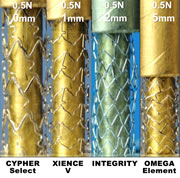|
November 30, 2011 -- A significant addition to the recent debate over coronary stent "shortening" during angioplasty received expedited publishing online today in JACC Cardiovascular Interventions, a publication of the American College of Cardiology. Seven stent designs were bench-tested for resistance to compression -- and the results for Boston Scientific's brand-new flagship PROMUS Element platform, approved by the FDA just last week, were not great. Of all seven stent designs tested, the "Omega Element" had the worst result, shrinking 5mm when compressed with 0.5 N of force. An older stent design, the Driver from Medtronic, also showed significant shortening, although less than the Element. What may make this report problematic for Boston Scientific is that, unlike the Driver which is being replaced by the Integrity design in Medtronic's new DES (currently sold in Europe and under review by the FDA), the Omega Element design is the basis for virtually all of Boston Scientific's new generation of stents. In the past few weeks, there have been a number of reports in the mainstream press, as well as in medical newsletters, about an uncommon phenomenon recently seen in some of the newer thinner-strut coronary stents, and most commonly in Boston Scientific's Element platform. In certain situations, especially in ostial lesions or when a catheter or other equipment is passed through a stent, the stent can be compressed or shortened slightly, leading to a "concertina effect". The stent no longer completely covers the intended area and it is possible, if not corrected, that this anatomic malapposition could lead to restenosis or clotting down the road. Luckily, if the phenomenon is identified readily by the cardiologist, it usually can be remedied quickly and simply by using a balloon inflation to reset the stent.
Dr. John A. Ormiston, lead author of the study, told Angioplasty.Org that when discussing the issue of longitudinal stent compression "perspective is very important" and that "it is not in the least like stent thrombosis which could be fatal." His paper, "Stent Longitudinal Integrity: Bench Insights Into a Clinical Problem", is an extensive report on the seven stent designs tested. Stents were pushed and pulled and measured to test their longitudinal strength, a bit like a thorough road test report for the latest Chevy. In fact the article concludes:
Interestingly, the best score was achieved by the recently discontinued and thicker-strutted Cypher stent, which showed no compression at all. The Cypher was the first drug-eluting stent approved by the FDA in 2003, but has since been surpassed in deliverability and effectiveness by the newer second and third generation DES. Cordis/J&J took it off the market and, having no new DES in the pipeline, completely withdrew from the coronary stent field earlier this year. But the performance of the Cypher demonstrates an important caveat to these measurements: there seems to be a trade-off between stent flexibility and ability to withstand longitudinal compression. In all stents the strut hoops have connecting welds. The Cypher has six connectors between the "hoops" of the stent, making it the most resistent to compression, but also making it the least flexible. The Vision and Multilink 8, which are the platforms used in Abbott's XIENCE V and newly approved XIENCE Prime, have three connectors, and these showed only 1mm of compression at 0.5 N of force. Both the Element and Driver have only two connectors and these showed compression of 5mm and 4mm respectively. The Integrity platform, while only using two connectors, scored close to the Abbott stents, which may be a result of its unique single-wire design which winds helically from one end of the stent to the other, combining strength and flexibility. As the authors note:
So what does Dr. Ormiston recommend? We asked him where he would be concerned about the negative effects of longitudinal compression, and he replied:
As to whether or not this is a significant issue (many of the interventional cardiologists polled by Angioplasty.Org feel that this is not a "such a big deal"), Dr. Ormiston replied:
So, while this may not be an issue of great significance numerically, it IS of import in a case-by-case review and interventional cardiologists need to be aware of longitudinal compression as a not-insignificant issue in certain anatomical situations. Reported by Burt Cohen, November 30, 2011 |


